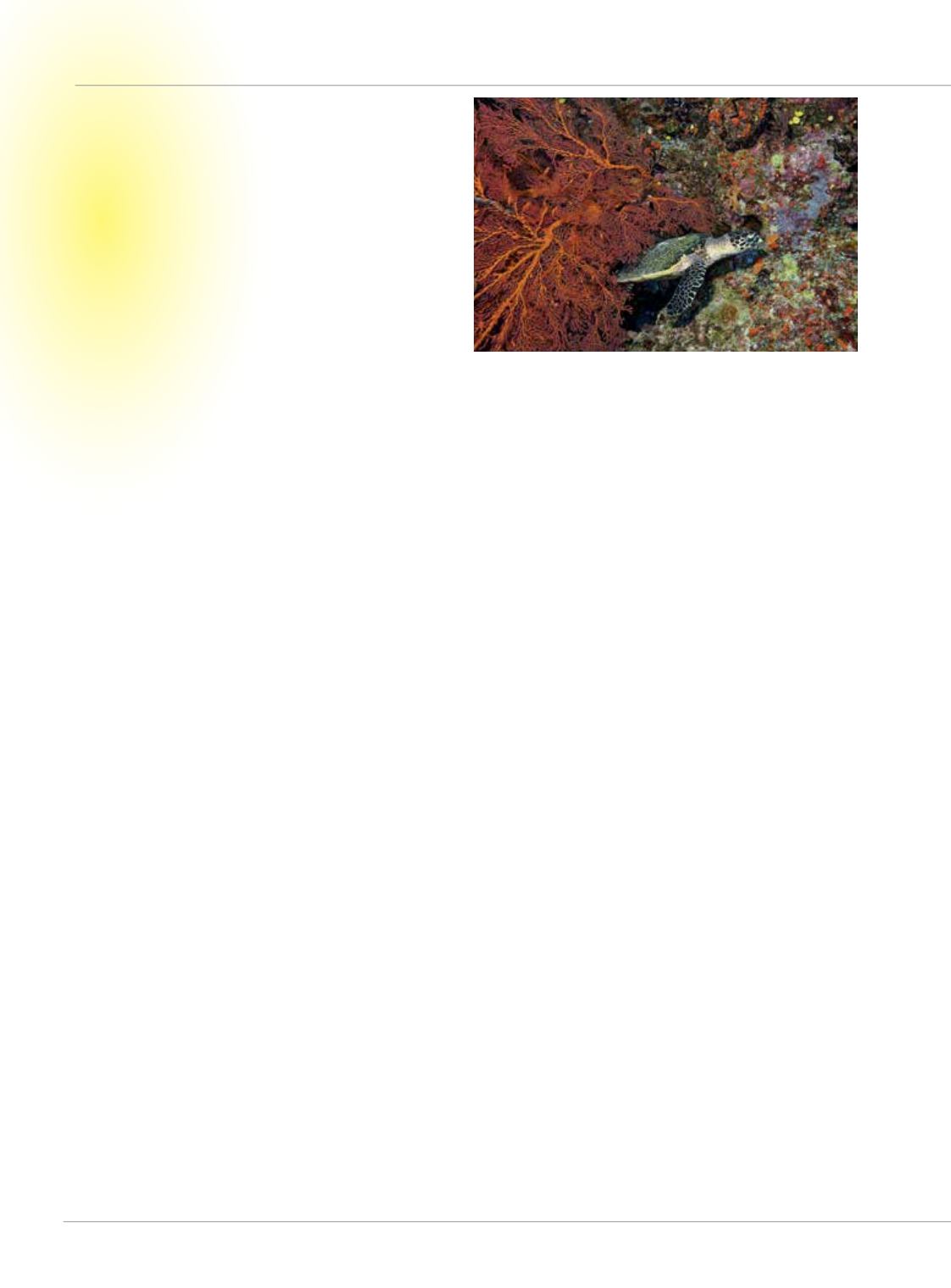

70
|
WINTER 2016
P
hotographers typically dive this site with a
wide-angle lens; this day I concentrated on
medium-sized fish portraits simply because
the backgrounds were so rich, textured
and colorful. While my yellow frogfish was
unsurprisingly absent, the rest of the site
was as pristine as ever. Revisiting the site
was an epiphany, a testament to the healing
waters that constantly flow through this
place, the soft coral capital of the world.
The fact that I was jumping into the water
here so soon after leaving Los Angeles is
insight into something notable about Fiji
diving: It is so very good and so very near.
Unlike some exotic dive destinations, which can involve
40-hour treks and hotel stays en route, Fiji is blessedly
accessible to North American travelers. From Los Angeles
International Airport, Fiji’s main island, Viti Levu, is a
direct, 11-hour flight away. The port of departure for
our liveaboard was just another two- to three-hour bus
ride from the Nadi International Airport. Leaving LAX
at midnight and gaining some hours by chewing through
time zones along the way allowed us to settle into our
cabins, prep our cameras and actually get into the water
on the very first day of the charter.
CRUISING THE VATU-I-RA PASSAGE
The first dive on many cruise itineraries, the dreaded
checkout dive, is quite often fairly marginal. These tend to
be close to shore and offer a shallow bottom so guests can
refresh rusty skills and dial in buoyancy on a reef sufficiently
devoid of life that an errant bump won’t matter. True to our
expectations, this dive was the least impressive of those we
did, but that was only because of the poor water clarity from
days of rain pouring into the near-shore waters. The dive
itself had potential for greatness.
At
Amazing Maze
, the amazing part was the series of
tunnels rimmed by soft corals and a profusion of anthias,
lionfish and clusters of anemones and clownfish. It would
have been stunning but for the detritus and particulate
matter that had washed onto the reef from nearby Viti
Levu. With a 100mm macro lens mounted, I was perfectly
happy to concentrate on reef minutiae. However, the
songs of an obviously nearby humpback whale kept
making me look up in expectation of the ultimate
photographic frustration: a friendly whale, crappy visibility
and a macro lens on my camera. I guess I was lucky I
never saw a whale so I could avoid that angst.
Seeing what the near-shore reefs delivered made it all
the more special to jump into the 150-foot visibility at
Mellow Yellow the next morning after an overnight steam
to the Bligh Water in the Vatu-I-Ra Passage. We weren’t
in Kansas anymore (but we’d be going there later).
The Bligh Water is named for William Bligh, who in
1789 found himself exiled from command of the HMS
Bounty
by master’s mate Fletcher Christian and a crew of 18
mutineers. Bligh and 18 loyal crewmembers were set adrift
in a 23-foot launch to embark on a 3,600-mile journey to
the Dutch port of Timor. Fear of cannibalism convinced
Bligh not to dawdle in these waters, but dawdling here for
the next 10 days was exactly what we had come to do.
After spending our first full day of the charter alternating
among Mellow Yellow,
Black Magic Mountain
and
Coral
Corner
, we steamed overnight to sample dive sites off the
island of Makogai. My first dive was at a site known as
Half
Pipe
. It would have been quite productive if for no other
reason than the giant crimson gorgonians that adorn the
face of the drop-off, all densely populated with small reef
dwellers such as fusiliers and anthias. But I was fortunate to
find an incredibly docile hawksbill turtle swimming along
the wall, weaving beneath and between the abundant filter
feeders. Of course there were the other usual reef suspects:
titan and clown triggerfish, puffers, whitetip reef sharks,
goatfish, clownfish and schooling Moorish idols. There
were smaller creatures for the macro enthusiasts such as
longnosed hawkfish, popcorn shrimp and leaf scorpionfish.
This was a very fruitful dive that we would revisit by
request later in the cruise.
After spending the day diving the nearby sites
Ratu
Ridge
and
Dominoes
, we visited a village on the island
of Makogai, a former leper colony. Before more humane
treatment for leprosy became the norm, lepers sometimes
were clubbed to death. When Fiji became a British colony,
clubbing was outlawed, and the Leper Ordinance Act of
1899 addressed the contagious nature of the disease by
preventing the infected from handling food for the public or
bathing in public pools. In 1908 the government isolated the
country’s lepers at Makogai Island, and in 1911 nuns from
the Missionary Sisters of the Society of Mary, along with a
















